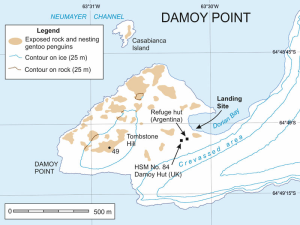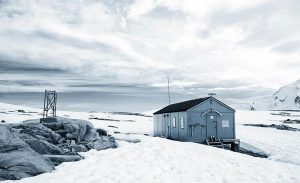 Damoy Point is a headland 900 metres west-northwest of Flag Point, the northern entrance point to the harbour of Port Lockroy, on the western side of Wiencke Island in the Palmer Archipelago of Antarctica. It was discovered and named by the French Antarctic Expedition, 1903–05, under Jean-Baptiste Charcot.
Damoy Point is a headland 900 metres west-northwest of Flag Point, the northern entrance point to the harbour of Port Lockroy, on the western side of Wiencke Island in the Palmer Archipelago of Antarctica. It was discovered and named by the French Antarctic Expedition, 1903–05, under Jean-Baptiste Charcot.
Wiencke Island 64° 49′ 22″ South, 63° 23′ 14″ West, is an island 6 km long and from 3 to 8 km wide, about 67 km2 in area, the southernmost of the major islands of the Palmenr Archipelago Two structures were erected on the shores of Dorian Bay; the Argentinean Refugio Bahia Dorian (WAP ARG-24) in 1957, and a larger building known as the  Damoy Hut in 1973 and used for several years as a British summer air facility and transit station for scientific personnel. It was last occupied in 1993, where it served flights to and from a summer-use ice-strip for aircraft used before the sea-ice cleared near Rothera Base. The Damoy Hut (aka Station L) and its ice-strip were closed in 1995: the building is now listed as an Historic Site and Monument and is maintained and administered by the United Kingdom Antarctic Heritage Trust (UKAHT).
Damoy Hut in 1973 and used for several years as a British summer air facility and transit station for scientific personnel. It was last occupied in 1993, where it served flights to and from a summer-use ice-strip for aircraft used before the sea-ice cleared near Rothera Base. The Damoy Hut (aka Station L) and its ice-strip were closed in 1995: the building is now listed as an Historic Site and Monument and is maintained and administered by the United Kingdom Antarctic Heritage Trust (UKAHT).
Both Argentinean Refugio Bahia Dorian (WAP ARG-24) and Damoy Hut (Station L) WAP GBR-31 have been activated by F5PFP signing respectively LU/FT5YJ and VP8DLM on March 2009. WAP does not have evidence of any other Ham radio activity before that date.
Find out more about Historic Site and Monument No. 84 by watching a short video on Damoy Hut. The site is Antarctica’s only protected historic transit facility and skyway, providing shelter and safe passage for scientists. (Courtesy of UKAHT)
Damoy is a well-preserved Hut containing scientific equipment and other artifacts was. It has been designated a Historic Site or Monument (HSM 84), following a proposal by the United Kingdom to the Antarcti Treaty Consultative Meeting.
For many, this was where they made their first Antarctic landing by ship. “As a first landfall in Antarctica it was hard to beat,” enthuses Steve Garrett, geophysicist. “Surely a candidate for the most beautiful place on Earth.”
The Hut became redundant in 1993 and by 2007 the building was due for demolition. However, it was saved and preserved as “an excellent example of Antarctic logistics and early air operations in Antarctica” helping us to understand the operational challenges of working in Antarctica. It takes its place as Historic Site and Monument No. 84 – one of only 33 buildings, and the sole transit facility, on the continent protected by the Antarctic Treaty.
 In 2023, UKART restored the Hut back to its original bright orange. The decision followed paint sampling by our conservation team in 2018 and research by paint scientist and conservator, Phillipa McDonnell, in 2019. The restoration of the original colour scheme improved the legibility of the Hut’s historic function as a transit centre and provides a key hook for the improved interpretation of the site as a whole as well as protecting it from the elements.
In 2023, UKART restored the Hut back to its original bright orange. The decision followed paint sampling by our conservation team in 2018 and research by paint scientist and conservator, Phillipa McDonnell, in 2019. The restoration of the original colour scheme improved the legibility of the Hut’s historic function as a transit centre and provides a key hook for the improved interpretation of the site as a whole as well as protecting it from the elements.
The work was undertaken by a small field team of one field guide and two conservation carpenters experienced in conserving historic buildings. They spent nearly four weeks on-site from mid-January, working around challenging weather to strip back the existing paint by hand, prime, and repaint the building to its original bright orange. As with any UKAHT conservation work, the team adhered to strict methodologies to ensure no contamination of the surrounding environment.
.
Thanks and credit to: https://www.ukaht.org/
